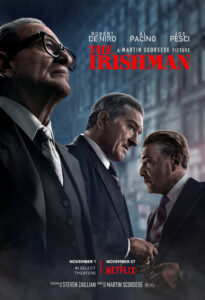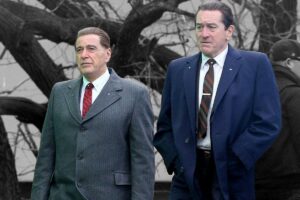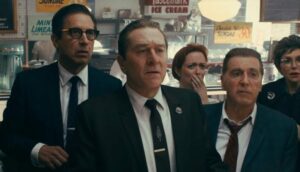“The Irishman” – the Retirement of a Gangster [Review]

Title: “The Irishman”
Release Date: 2019
Director: Martin Scorsese
Cast: Robert De Niro, Joe Pesci, Al Pacino, Bobby Cannavale, Anna Paquin, Stephen Graham
Martin Scorsese’s “The Irishman” is a film deliberately composed of the most iconic bits of gangster cinema. Nevertheless, the picture can be read not only as a tribute to old Hollywood. Scorsese evokes old conventions to show, in a way, the continuation of all the stories about the gangster boss – to look at him at the end of his life, in a retirement home, during his last confession.
“The Irishman” – the return of old Hollywood
“The Irishman” is a film in which Scorsese returns to a favorite theme, using all his best ideas. From the beginning, there is no doubt that this is the work of this particular director. In terms of narrative, it is the most reminiscent of “Goodfellas” and “Casino”. What we have here is Scorsese’s characteristic nervous rhythm of action, fully subordinated to the protagonist’s subjective vision. The story is so long that the viewer has to be careful not to get lost in the threads of the complicated intrigue.
The main character of the film is the Irishman of the title, Frank Sheeran, who at the end of his life, in an old people’s home, tells the story of his mafia activities. We see how a driver stealing meat gradually enters mafia structures and climbs the steps of “promotion”. As his position changes, so does the level of difficulty of the orders he is given: He moves from stealing to destroying property, and finally to brutal murders. The story picks up speed and spins like a merry-go-round, and just when it seems that nothing in this line of work can surprise the protagonist, Sheeran receives an assignment that is definitely different from the others. Will it affect the psyche of the mafioso? This is one of the key questions Scorsese asks himself throughout his work, constantly placing the characters in a violent world and watching their reactions to the escalation of evil.

Of course, the lead role had to be played by Robert De Niro, an actor whom Scorsese discovered and launched in “Mean Streets” (1973) and then cast in all his great films: “Taxi Driver” (1975), “Raging Bull” (1980), and “Goodfellas”(1990). De Niro here opens a plethora of great stars of gangster cinema. The film also features such legends as Harvey Keitel, Joe Pesci and Al Pacino, who played Scorsese for the first time. The latter, by his very person, evokes “The Godfather” trilogy. The Irishman deftly alludes to Francis Ford Coppola’s picture, for example in the form of the famous music or the theme of the wedding of a powerful gangster’s daughter, which the protagonists go to. However, the film also contains references to other classics revising the gangster myth, such as Quentin Tarantino’s radical “Pulp Fiction”.
And it could not do without New York. Scorsese is, after all, a great praiser of the city, from “Taxi Driver” to “New York, New York” (1977) with Liza Minnelli to “Gangs of New York” (2002).
“I heard you paint houses” – an ironic reworking of the gangster world
“The Irishman”, however, is a film in which Scorsese builds a double distance from the cinematic story. Firstly, he brackets the gangster world, which he did consistently already in “Goodfellas” and “Casino”. Secondly, the director clearly transforms the classic motifs of gangster cinema and noir aesthetics. As far as the distance from the presented story is concerned, it is created above all by the clear convention of the main character’s first-person narration.
In “The Irishman” we see the world through Sheeran’s eyes and we see only as much as he wants to tell us, while he deliberately keeps silent and misrepresents certain facts. Therefore, there are some gaps in the story: for example, we do not know much about the protagonist’s family, even though he declares that they play an important role in his life. Moreover, such a procedure makes the presented world, just like the main character’s life, extremely hermetic: there is no reality outside the mafia. This is additionally emphasized by numerous scenes taking place in closed interiors: apartments, stores or boarding houses. Scorsese thus emphasizes that he does not identify with the protagonist’s value system – he gives him a voice and presents his vision of the world, and leaves the evaluation to the viewers.

The second layer of distance in “The Irishman” is an ironic reworking of the conventions of the genre. Watching the film, I had an irresistible impression that it is emphasized by the very computer rejuvenation of the main characters. The bizarre effect of this process fits perfectly into the film’s pastiche-parodying statement on the world of gangsters and gangster cinema itself. The mafiosi, contrary to the image created by pop culture, are not beautiful and young at all. This impression is reinforced by the information appearing on screen about the dates and circumstances of the deaths of the various characters. We see them as early as the introduction of the characters, which creates an ironic commentary to their supposed greatness, which appears as a small insignificant moment leading to a tragic end.
Moreover, the numerous intertextual references to other films, as well as the comedy resulting from the absurdity of the language and situations, have a pastiche-like overtone. Already in the first sentences which Sheeran utters, we have an opportunity to get to know the specific, absurd slang used by the people of the mafia. The sentence “I heard you were painting houses”, meant to express the essence of the dirty gangster’s job, becomes a leitmotif of the whole film. It also perfectly illustrates the comical enigmatic nature of this language, which even its users do not fully understand. It also does not serve the purpose of clear communication between the members of the mafia clan, which is emphasized by an extremely comical situation when Sheeran is asked to mediate in negotiations between Jimmy Hoffa and the mafia leaders.
Furthermore, the language becomes a sort of autonomous creation that constructs various figures of anxiety for the characters. When, for example, an illogical execution is to be carried out, the ordering parties argue that “the union leader” has decided so. But who is this mob boss? When Sheeran asks this question to Russell Buffalino, who is, after all, at the very top of the mafia, Buffalino replies that “the mountain” was behind the assassination of President Kennedy. Language, then, becomes a tool for creating a panaroic vision of the world, where, almost like in Franz Kafka’s work, danger lurks everywhere and one does not know when and for what reason one can fall into disgrace and simply disappear without a trace. The specific gangster speech therefore becomes a method of mythologizing mafia leaders, giving them almost divine attributes, and it is as such that it is unmasked and parodied in the film.

“The Irishman” – retired gangster
Scorsese does not limit himself to pastiche commentary on cinema and his own work, however. “The Irishman” is a film that penetrates the protagonist’s psyche much deeper than his previous mafia pictures. It does not show the tragic end of the protagonist as in “Casino”, nor does it show him leaving the mafia circle to become a “nobody” as in “Goodfellas”. Sheeran happily lives to a ripe old age and waits quietly for his death in a retirement home. Nothing happens, no one tries to liquidate him, and the paradox of his situation is best expressed by Frank’s surprise when he learns that his former lawyer was not killed by the Mafia, but died of “ordinary” cancer.
At this point, nonetheless, during the protagonist’s final confession, the film’s big question opens up about the real condition of a gangster who has spent his entire life navigating the world of shady deals and brutal murders. What does he regret? What has he gained and what has he lost? And more than that, I think Irishman doesn’t just stop at that question. The sight of this retired gangster, and especially his relationship with his daughters, which makes him painfully aware of the illusions in which Frank existed, seems to provide some answers that are not easy. His own answers. Or perhaps the answers of Martin Scorsese, an old master of cinema who sums up his work?

